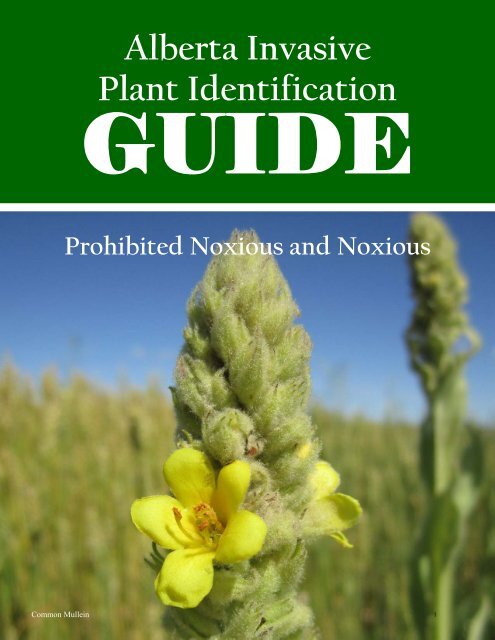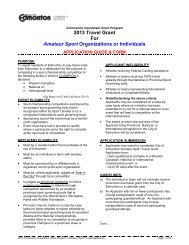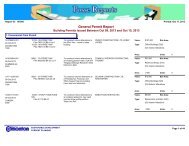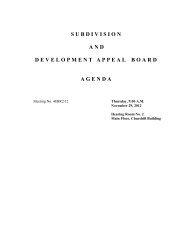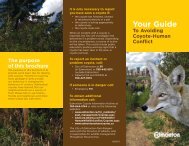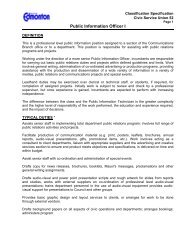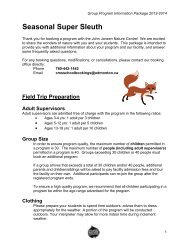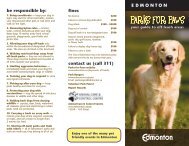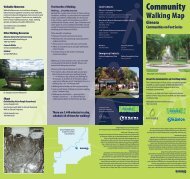Alberta Invasive Plant Identification Guide
Alberta Invasive Plant Identification Guide
Alberta Invasive Plant Identification Guide
Create successful ePaper yourself
Turn your PDF publications into a flip-book with our unique Google optimized e-Paper software.
<strong>Alberta</strong> <strong>Invasive</strong><br />
<strong>Plant</strong> <strong>Identification</strong><br />
GUIDE<br />
Prohibited Noxious and Noxious<br />
Common Mullein 1
Credits<br />
Information Credit:<br />
Montana State University <strong>Invasive</strong> <strong>Plant</strong> <strong>Identification</strong> <strong>Guide</strong><br />
<strong>Alberta</strong> <strong>Invasive</strong> <strong>Plant</strong> Council<br />
Weeds of Canada<br />
Weeds of the Prairies<br />
Manitoba Agriculture, Food and Rural Initiatives<br />
Ontario Ministry of Agriculture and Rural Affairs<br />
A field guide to <strong>Invasive</strong> <strong>Plant</strong>s of Wisconsin<br />
Photo Credits:<br />
Wheatland County<br />
Montana State University<br />
<strong>Alberta</strong> <strong>Invasive</strong> <strong>Plant</strong> Council<br />
<strong>Alberta</strong> Sustainable Resource Development<br />
<strong>Invasive</strong>.org (UGA photos)<br />
Sarah Schumacher<br />
Sponsors/Acknowledgement:<br />
<strong>Alberta</strong> Agriculture and Rural Development<br />
Produced by Wheatland County<br />
Contact: 403.934.3321 for more information<br />
2
<strong>Alberta</strong> <strong>Invasive</strong><br />
<strong>Plant</strong> <strong>Identification</strong><br />
GUIDE<br />
2012<br />
3
INDEX: Prohibited Noxious & Noxious Weeds<br />
Pg. 5 - Introduction to the <strong>Alberta</strong> Weed Act<br />
Pg. 6 - Parts of a Flower<br />
Pg. 7-10 Thumbnails<br />
Prohibited Noxious Weeds<br />
Pg. 12 - Autumn Olive, Elaeagnus umbellata<br />
Pg. 13 - Balsam, Himalayan, Impatiens glandulifera<br />
Pg. 14 - Barberry, Common, Berberis vulgaris<br />
Pg. 15 - Bartsia, Red, Odontites vernus<br />
Pg. 16 - Buckthorn, Common, Rhamnus cathartica<br />
Pg. 17 - Cinquefoil, Sulphur, Potentilla recta<br />
Pg. 18 - Crupina, Common, Crupina vulgaris Persoon<br />
Pg. 19 - Dyer’s Woad, Isatis tinctoria<br />
Pg. 20 - Eurasian Water Milfoil, Myriophyllum spicatum<br />
Pg. 21 - Flowering Rush, Butomus umbellatus<br />
Pg. 22 - Garlic Mustard, Alliaria petiolata<br />
Pg. 23 - Goatgrass, Jointed, Aegilops cylindrica Host<br />
Pg. 24 - Hawkweed, Meadow, Hieracium caespitosum<br />
Pg. 24 - Hawkweed, Mouse‑ear, Hieracium pilosella<br />
Pg. 25 - Hawkweed, Orange, Hieracium aurantiacum<br />
Pg. 26 - Hoary Alyssum, Berteroa incana<br />
Pg. 27 - Hogweed, Giant, Heracleum mantegazzianum<br />
Pg. 28 - Iris, pale yellow, Iris pseudacorus<br />
Pg. 29 - Knapweed, Bighead, Centaurea macrocephala<br />
Pg. 30 - Knapweed, Black, Centaurea nigra<br />
Pg. 30 - Knapweed, Brown, Centaurea jacea<br />
Pg. 31 - Knapweed, Diffuse, Centaurea diffusa<br />
Pg. 32 - Knapweed, Hybrid, Centaurea × psammogena<br />
Pg. 30 - Knapweed, Meadow, Centaurea × moncktonii<br />
Pg. 33 - Knapweed, Russian, Acroptilon repens<br />
Pg. 34 - Knapweed, Spotted, Centaurea stoebe<br />
Pg. 35 - Knapweed, Squarrose, Centaurea virgata<br />
Pg. 36 - Knapweed, Tyrol, Centaurea nigrescens<br />
Pg. 37 -Knotweed, Giant, Fallopia sachalinensis<br />
Pg. 37 - Knotweed, Hybrid Japanese, Fallopia x bohemica<br />
Pg. 37 - Knotweed, Japanese, Fallopia japonica<br />
Pg. 38 - Loosestrife, Purple, Lythrum salicaria<br />
Pg. 39 - Medusahead, Taeniatherum caput<br />
Pg. 40 - Nutsedge, Yellow, Cyperus esculentus<br />
Pg. 41 - Puncturevine, Tribulus terrestris<br />
Pg. 42 - Ragwort, Tansy, Senecio jacobaea<br />
Pg. 43 - Rush Skeletonweed, Chondrilla juncea<br />
Pg. 44 - Saltcedar, Tamarix ramosissima<br />
Continued; Prohibited Noxious Weeds<br />
Pg. 45 - Saltlover, Halogeton glomeratus<br />
Pg. 46 - St John’s‑wort, common, Hypericum perforatum<br />
Pg. 47 - Starthistle, Yellow, Centaurea solstitialis<br />
Pg. 44 - Tamarisk, Chinese, Tamarix chinensis<br />
Pg. 44 - Tamarisk, smallflower, Tamarix parviflora<br />
Pg. 48 - Thistle, Marsh, Cirsium palustre<br />
Pg. 49 - Thistle, Nodding, Carduus nutans<br />
Pg. 50 - Thistle, Plumeless, Carduus acanthoides<br />
Noxious Weeds<br />
Pg. 52 - Baby’s Breath, Common, Gypsophila paniculata<br />
Pg. 53 - Bellflower, Creeping, Campanula rapunculoides<br />
Pg. 54 - Bindweed, Field, Convolvulus arvensis<br />
Pg. 55 - Blueweed, Echium vulgare<br />
Pg. 56 - Brome, Downy, Bromus tectorum<br />
Pg. 57 - Brome, Japanese, Bromus japonicus<br />
Pg. 58 - Burdock, Great, Arctium lappa<br />
Pg. 58 - Burdock, Lesser, Arctium minus<br />
Pg. 58 - Burdock, Woolly, Arctium tomentosum<br />
Pg. 59 - Buttercup, Tall, Ranunculus acris<br />
Pg. 60 - Chamomile, Scentless, Tripleurospermum perforatum<br />
Pg. 61 - Clematis, Yellow, Clematis tangutica<br />
Pg. 62 - Cockle, White, Silene latifolia Poiret ssp.<br />
Pg. 63 - Daisy, Oxeye, Leucanthemum vulgare<br />
Pg. 64 -Dame’s Rocket, Hesperis matronalis<br />
Pg. 65 - Henbane, Black, Hyoscyamus niger<br />
Pg. 66 - Hoary cress, globe‑podded, Lepidium appelianum<br />
Pg. 66 - Hoary cress, heart‑podded, Lepidium draba<br />
Pg. 66 - Hoary cress, lens‑podded, Lepidium chalepense<br />
Pg. 67 - Hound’s tongue, Cynoglossum officinale<br />
Pg. 68 - Mullein, Common, Verbascum thapsus<br />
Pg. 69 - Pepper‑grass, broad‑leaved, Lepidium latifolium<br />
Pg. 70 - Scabious, Field, Knautia arvensis<br />
Pg. 71 - Sow Thistle, Perennial, Sonchus arvensis<br />
Pg. 72 - Spurge, Leafy, Euphorbia esula<br />
Pg. 73 - Tansy, Common, Tanacetum vulgare<br />
Pg. 74 - Thistle, Canada, Cirsium arvense<br />
Pg. 75 - Toadflax, Dalmatian, Linaria dalmatica<br />
Pg. 76 - Toadflax, Yellow, Linaria vulgaris<br />
Pg. 77 - 78 Glosary<br />
4<br />
Pg. 79 - 80 Weed Tools
<strong>Alberta</strong> Weed Control Act<br />
Legislation<br />
In 2010 a new Weed Control Act was Proclaimed. The new Weed Control<br />
Act regulation includes a new schedule of weed designations. Previously<br />
there were three weed categories, restricted weeds, noxious weeds and<br />
nuisance weeds. These categories were replaced with the new weed<br />
designations of Prohibited Noxious and Noxious.<br />
Prohibited Noxious Weed: means a plant designated in accordance<br />
with the regulations as a prohibited noxious weed and includes the plant’s<br />
seeds. This weed designation can be seen as regulatory support for an<br />
“Early Detection, Rapid Response” stage of invasive plant management.<br />
<strong>Plant</strong>s in this category are either not currently found in <strong>Alberta</strong> or are<br />
found in few locations such that eradication could be possible. Under the<br />
Weed Control Act a person has a responsibility to destroy a prohibited<br />
noxious weed.<br />
Noxious Weed: means a plant designated in accordance with the regulations<br />
as a noxious weed and includes the plant’s seeds. This weed designation<br />
can be seen as regulatory support for a “containment” stage of invasive<br />
plant management. <strong>Plant</strong>s listed in this category are considered to<br />
widely distributed to eradicate. A local authority may conduct control programs<br />
for these weeds if they feel they may have significant ecological or<br />
economic impact on lands within their municipality.<br />
The full Weed Control Act is available on line at the <strong>Alberta</strong> Queens<br />
Printer Website or at: www.agriculture.alberta.ca<br />
If you have questions or concerns regarding the <strong>Alberta</strong> Weed<br />
Control Act contact:<br />
The <strong>Alberta</strong> Ag-Info Centre Phone: 310-FARM or 310-3276 or,<br />
Your local County or municipal Agricultural Fieldman or Weed<br />
Inspector<br />
5
http://www.mhhe.com/biosci/pae/botany/botany_map/articles/article_22.html<br />
http://www.clemson.edu/extension/natural_resources/landowner/youth_environ_education/terminology.html<br />
From Stern, Introductory <strong>Plant</strong> Biology, 8th edition, © 2000 McGraw-Hill Companies, Inc.<br />
<strong>Identification</strong> Tools<br />
6<br />
http://www.tutorvista.com/biology/simple-leaf-arrangement<br />
http://www.cactus-art.biz/note-book/Dictionary/Dictionary_F/dictionary_flower.htm http://www.vplants.org/plants/glossary/poaceae.html
White Flowers<br />
Scentless<br />
Chamomile<br />
Pg. 60<br />
Diffuse Knapweed<br />
Pg. 31<br />
Broad-Leaved<br />
Pepper Grass<br />
Pg. 69<br />
Pink Flowers<br />
Field Bindweed<br />
Pg. 54<br />
Hoary Alyssum<br />
Pg. 26<br />
Autumn Olive<br />
Pg. 12<br />
Saltlover<br />
Pg. 45<br />
Weed Thumbnails<br />
Hoary Cress<br />
Pg. 66<br />
Knotweed<br />
Complex<br />
Pg. 37<br />
Giant Hogweed<br />
Pg. 27<br />
Field Scabious<br />
Pg. 70<br />
Common Baby’s<br />
Breath<br />
Pg. 52<br />
Common<br />
Buckthorn<br />
Pg. 16<br />
Garlic Mustard<br />
Pg. 22<br />
White Cockle<br />
Pg. 62<br />
Oxeye Daisy<br />
Flowering Rush<br />
Pg. 21<br />
Squarrose knapweed<br />
Pg. 35<br />
7
Purple Flowers<br />
Purple Loosestrife<br />
Pg. 38<br />
Plumeless Thistle<br />
Pg. 50<br />
Hounds Tongue<br />
Pg. 67<br />
Creeping<br />
Bellflower<br />
Pg. 53<br />
Russian Knapweed<br />
Pg. 33<br />
Weed Thumbnails<br />
Common Crupina<br />
Pg. 18<br />
Salt Cedar<br />
Pg. 44<br />
Dame’s Rocket<br />
Pg. 64<br />
Spotted<br />
Knapweed<br />
Pg. 34<br />
Himalayan Balsam<br />
Pg. 13<br />
Burdock<br />
Pg. 58 Canada Thistle<br />
Red Bartsia<br />
Pg. 15<br />
Marsh Thistle<br />
Pg. 48<br />
Nodding Thislte<br />
Pg. 49<br />
Tyrol Knapweed<br />
Pg. 36<br />
8
Yellow Flowers<br />
Hawkweed spp.<br />
Pg. 24<br />
Tansy Ragwort<br />
Pg. 42<br />
Yellow Star Thistle<br />
Pg. 47<br />
Yellow Clematis<br />
Pg. 61<br />
Weed Thumbnails<br />
St. John’s Wort<br />
Pg. 46<br />
Cinquefoil, Sulfur<br />
Pg. 17<br />
Iris, Pale Yellow<br />
Pg. 28 Yellow Toadflax<br />
Common Barberry<br />
Pg. 14<br />
Leafy Spurge<br />
Pg. 72<br />
Puncture Vine<br />
Pg. 41<br />
Dyer’s Woad<br />
Pg. 19<br />
Tall Buttercup<br />
Pg. 59<br />
Rush Skeleton<br />
Weed<br />
Common Tansy<br />
Pg. 73<br />
Bighead Knapweed<br />
Pg. 29<br />
Dalmatian<br />
Toadflax<br />
Pg. 75<br />
9
Yellow Flowers<br />
Yellow Nutsedge<br />
Pg. 40<br />
Green Flowers<br />
Eurasian Water Milfoil<br />
Pg. 20<br />
Thumbnails<br />
Orange Flowers Blue Flowers<br />
Orange Hawkweed<br />
Pg. 25<br />
Perennial Sow Thistle<br />
Pg. 71<br />
Downy Brome<br />
Pg. 56<br />
Blueweed<br />
Common Mullin<br />
Pg. 68<br />
Jointed Goat<br />
Grass<br />
Pg. 23<br />
Japanese Brome<br />
Pg. 57<br />
Medusa Head<br />
Pg. 39<br />
Dark Purple Flowers<br />
Black Henbane<br />
10
Prohibited<br />
Noxious Weeds<br />
Prohibited Noxious weeds pose a serious threat and must be eradicated. These<br />
weeds spread rapidly and are highly competitive. Weeds in this category are<br />
restricted to prevent establishment in <strong>Alberta</strong>.<br />
11
Jeffery Pippen www.duke.edu/~jspippen/plants/elaeagnus.htm www.ct-botanical-society.org/galleries/elaeagnusumbe.html<br />
Autumn Olive<br />
Elaeagnus umbellate, Elaeagnaceae<br />
Category: Prohibited Noxious<br />
Information: Tolerant of a wide range of conditions.<br />
Life Cycle: Perennial shrub.<br />
Root: Nitrogen fixing, woody root.<br />
Leaves: Simple, alternate, silver-grey color, wavy leaf margins.<br />
Stems: Multi-stems, up 6m tall.<br />
www.ct-botanical-society.org/galleries/elaeagnusumbe.html<br />
Flower: Tube/bell shaped, fragrant, creamy white to yellow flowers.<br />
Seed/Fruits: Small, fleshy, red, egg shaped with scales.<br />
Control: Manual (hand pull seedlings), mechanical, chemical.<br />
12<br />
Jeffery Pippen www.duke.edu/~jspippen/plants/elaeagnus.htm<br />
Jeffery Pippen www.duke.edu/~jspippen/plants/elaeagnus.htm
Balsam, Himalayan<br />
Impatiens glandulifera, Balsaminaceae (Impatiens family)<br />
Category: Prohibited Noxious<br />
• Information: Originally from India, introduced as an ornamental, other<br />
names include Policeman's Helmet, Impatiens, Touch-me-not. Is a weed of<br />
concern because of potential impacts on riparian areas.<br />
• Life Cycle: Annual.<br />
Ron Bartholow, Wheatland County Tom Heutte, USDA Forest Service, Bugwood.org<br />
• Root: Shallow and fibrous.<br />
• Leaves: Simple, oblong, large, serrated edge, oppositely arranged on the<br />
stem.<br />
• Stems: Large, hollow, 4 sided, grows up to 120cm.<br />
• Flower: Showy, irregular, pink-purple-white, 5 petals.<br />
• Seed/Fruits: Pods are explosive when ripe, seeds can shoot up to10m,<br />
and can float.<br />
• Control: Do not plant, easily pulled by hand.<br />
Ron Bartholow, Wheatland County<br />
Wheatland County<br />
13<br />
Ron Bartholow, Wheatland County
Leslie J. Mehrhoff, University of Connecticut, Bugwood.org<br />
Barberry, Common<br />
Berberis vulgaris, Berberidaceae (Barberry Family)<br />
Category: Prohibited Noxious<br />
•Information: Introduced from Europe and Asia as an ornamental, this<br />
weed is tolerant of a wide range of conditions.<br />
•Life Cycle: Perennial shrub.<br />
•Root: Woody.<br />
•Leaves: Alternate, spines occurring at the base of each leaf, leaf margins<br />
finely toothed, dull green, 2-5cm long.<br />
•Stems: 1-3m tall, bushy shrub, yellow-grey, spines in groups of 3.<br />
•Flower: Hanging cluster of yellow flowers, 10-20 flowers per raceme<br />
(inflorescence).<br />
•Seed/Fruits: Red clusters of berries, individual berries are 1cm long, 1-3<br />
black seeds per berry.<br />
•Toxicity: Alternate host for stem rust fungus.<br />
•Control: Manual control, treat stumps in autumn, early control.<br />
14<br />
Leslie J. Mehrhoff, University of Connecticut, Bugwood.org<br />
Leslie J. Mehrhoff, University of Connecticut, Bugwood.org
http://commons.wikimedia.org/wiki/File:Red_bartsia_800.jpg<br />
Bartsia, Red<br />
Odontites vernus, Scrophulariaceae (Figwort family)<br />
Category: Prohibited Noxious<br />
• Information: Originated from Europe, is a weed of pastureland, hayland<br />
and roadside ditches.<br />
•Life Cycle: Annual.<br />
•Root: Taproot<br />
• Leaves: Narrow and hairy with a toothed edge. Leaves are oppositely arranged<br />
and clasp the stem.<br />
• Stems: Upright, branching, 15-30cm tall.<br />
• Flower: Snapdragon type flower, reddish purple, hairy.<br />
• Seed/Fruits: 1400 seeds per plant, hairy.<br />
• Toxicity: May be parasitic to grasses.<br />
• Control: Cultivation.<br />
http://botanika.wendys.cz/kytky/K272.php<br />
http://commons.wikimedia.org/wiki/File:Red_bartsia_800.jpg<br />
15<br />
http://dominiquegaudefroy.fr/EXPOAVRIL2008/EXPO-CALCICOLES-DEUXIEME-PARTIE.html
Permission granted by e-mail on June 28, 2011 by Gary Fewless<br />
•Information: Originated from Eurasia, introduced as an ornamental<br />
plant, tolerant of a wide range of conditions.<br />
•Life Cycle: Perennial woody shrub.<br />
•Root: Woody root.<br />
Buckthorn, Common<br />
Rhamnus cathartica, Rhamnaceae<br />
Category: Prohibited Noxious<br />
•Leaves: Dark green, glossy, oval shaped, pointed tip, 3-4 veins, slightly<br />
jagged edges.<br />
•Stems: Shrub or small tree, trunk up to 25cm in diameter, up to 7m tall,<br />
grey-brown, rough texture, twigs tipped with a spine.<br />
•Flower: Yellow/ yellow-green, 4 petals, male and female flowers on separate<br />
plants.<br />
•Seed/Fruits: Small black fruit, 3-4 seeds.<br />
•Control: Mechanical, basal bark treatment.<br />
16<br />
Jan Samanek, State Phytosanitary Administration, Bugwood.org
Montana State University <strong>Invasive</strong> <strong>Plant</strong> <strong>Identification</strong> <strong>Guide</strong><br />
Cinquefoil, Sulphur<br />
Potentilla recta, Rosaceae (Rose family)<br />
Category: Prohibited Noxious<br />
•Life cycle: Annual, biennial or perennial.<br />
•Root: Fibrous spreading roots.<br />
Montana State University <strong>Invasive</strong> <strong>Plant</strong> <strong>Identification</strong> <strong>Guide</strong> Montana State University <strong>Invasive</strong> <strong>Plant</strong> <strong>Identification</strong> <strong>Guide</strong><br />
•Leaves: Palmately compound with 5-7 toothed leaflets; relatively few basal leaves.<br />
Most leaves grow along upright stem. Leaves stalked; leaf stalk length and size decreasing<br />
toward apex.<br />
•Stems: One to several erect stems 30-60cm tall, may be branched with terminal,<br />
multi-flower inflorescence. Stems have hairs perpendicular to stem and leafstalks.<br />
•Flower: Five light yellow petals with deeply notched tips and a yellow center.<br />
•Seed/Fruit: Comma-shaped, brownish purple, covered with net-like ridges.<br />
Note: These characteristics distinguish sulphur cinquefoil from native cinquefoils. Sulphur<br />
Cinquefoil leaves are green, not silvery, on the underside; its seeds are ridged<br />
while others usually are not; it has comparatively more stem leaves and fewer basal<br />
leaves than other Potentilla species, and its hairs are at right angles to the stem while<br />
others are usually oppressed.<br />
http://www.invasiveplants.ab.ca/Downloads/FS-SulfurCinquefoil.pdf<br />
17<br />
www.invasiveplants.ab.ca/<br />
Montana State University <strong>Invasive</strong> <strong>Plant</strong> <strong>Identification</strong>
Montana State University <strong>Invasive</strong> <strong>Plant</strong> <strong>Identification</strong> <strong>Guide</strong> Montana State University <strong>Invasive</strong> <strong>Plant</strong><br />
Crupina, Common<br />
Crupina vulgaris, Asteraceae (Sunflower Family)<br />
Category: Prohibited Noxious<br />
• Life cycle: Winter annual.<br />
• Root: Short taproot.<br />
• Leaves: Fleshy oval seedling leaves widest near the tip, with distinct<br />
purple midrib. Rosette and stem leaves pinnately lobed with short stiff<br />
spines, alternate and smaller toward the apex.<br />
• Stems: One main stem 30-90cm tall, branch several times.<br />
• Flower: One to five, 1.5cm long flower heads at branch tips or in upper<br />
leaf axils. Narrow (length three to four times greater than width) rosepurple<br />
petals.<br />
• Seed/Fruit: A ring of dark, stiff bristles encircle the seed.<br />
• Control:<br />
Montana State University <strong>Invasive</strong> <strong>Plant</strong> <strong>Identification</strong> <strong>Guide</strong><br />
Montana State University <strong>Invasive</strong> <strong>Plant</strong> <strong>Identification</strong> <strong>Guide</strong><br />
18<br />
Montana State University <strong>Invasive</strong> <strong>Plant</strong> <strong>Identification</strong> <strong>Guide</strong>
Montana State University <strong>Invasive</strong> <strong>Plant</strong> <strong>Identification</strong> <strong>Guide</strong><br />
Dyer’s Woad<br />
Isatis tinctoria, Brassicaceae (Mustard Family)<br />
Category: Prohibited Noxious<br />
•Life cycle: Winter annual, biennial or short-lived perennial.<br />
•Root: Taproot and some lateral roots.<br />
•Leaves: All leaves bluish-green with white midrib. Rosette (first form)<br />
leaves have long slender stalks, are widest near the tip and covered with<br />
soft hairs. Stem leaves lack hairs, are alternate, lance shaped, and clasp the<br />
stem.<br />
•Stems: 30 - 120cm tall, multi-branching.<br />
•Flower: Cluster on upper stem in a flat-topped inflorescence. Yellow petals<br />
3mm long and wide.<br />
•Seed/Fruit: Purplish brown, tear drop shaped seed pods hang from small<br />
stalks.<br />
•Control: Chemical.<br />
Montana State University <strong>Invasive</strong> <strong>Plant</strong> <strong>Identification</strong> <strong>Guide</strong> Montana State University <strong>Invasive</strong> <strong>Plant</strong> <strong>Identification</strong> <strong>Guide</strong><br />
19<br />
Montana State University <strong>Invasive</strong> <strong>Plant</strong> <strong>Identification</strong> <strong>Guide</strong>
Montana State University <strong>Invasive</strong> <strong>Plant</strong> <strong>Identification</strong> <strong>Guide</strong><br />
Eurasian Water Milfoil<br />
Myriophyllum spicatum , Haloragaceae (Water Milfoil Family)<br />
Category: Prohibited Noxious<br />
Montana State University <strong>Invasive</strong> <strong>Plant</strong> <strong>Identification</strong> <strong>Guide</strong><br />
• Life cycle: Aquatic perennial.<br />
• Root: Numerous at base and along stem.<br />
• Leaves: Three to four bright-green leaves, 3cm long with 12 to 48 threadlike<br />
divisions are whorled around stem at each joint. Leaves<br />
rarely extend above water surface and mat when removed from water.<br />
• Stems: Slender, hairless, leafless toward base, 3m long or longer and<br />
2mm thick. Grow to water surface then branch forming dense floating mats.<br />
Somewhat whitened when dry.<br />
• Flower: Rigid, pink flowering spike, 5 to 20cm long, held erect above water<br />
surface. Small, yellow, four petaled flowers arranged in clusters.<br />
• Seed/Fruit: Hard, segmented capsule contains four seeds.<br />
20<br />
Montana State University <strong>Invasive</strong> <strong>Plant</strong> <strong>Identification</strong> <strong>Guide</strong>
Flowering Rush<br />
Butomus umbellatus, Butomaceae (Flowering Rush Family)<br />
Category: Prohibited Noxious<br />
Montana State University <strong>Invasive</strong> <strong>Plant</strong> <strong>Identification</strong> <strong>Guide</strong><br />
Information: Thrives in moist areas such as sloughs and canals.<br />
Life cycle: Perennial.<br />
Root: Thick creeping rhizomes and bulblets.<br />
Leaves: Erect or floating leaves, opposite, 90cm long and 1 -1.5cm wide<br />
with smooth edges, triangular cross section, and twisted ends.<br />
Stems: Leafless, green and have a round cross section.<br />
Flower: Three purplish brown bracts where flower stalk attaches to<br />
stem tip. Umbrella-shaped clusters of pink to white flowers with three<br />
petals 2-3cm in diameter.<br />
Seed/Fruit: Inflated, dark brown beaked fruits 1-1.5cm long.<br />
Control:<br />
Sarah Schumacher, Wheatland County<br />
round flower stem<br />
triangular leaf stem<br />
Sarah Schumacher, Wheatland County<br />
Sarah Schumacher, Wheatland County<br />
21<br />
Sarah Schumacher, Wheatland County<br />
Ron Bartholow, Wheatland County
Chris Evans, River to River CWMA, Bugwood.org<br />
Garlic Mustard<br />
Alliaria petiolata, Brassicaceae (Mustard Family)<br />
Category: Prohibited Noxious<br />
Information: Grows in moist, woody areas.<br />
Life Cycle: Herbaceous biennial, Rosette in the first years growth, flowers<br />
in the second.<br />
Root: White, slender taproot.<br />
Leaves: Rosette leaves are heart shaped and dark. Mature leaves are<br />
spade shaped with a jagged, toothed edge. Leaves are alternately arranged<br />
on the stem and have a garlic odor when crushed.<br />
Stems: <strong>Plant</strong> can grow from 1-1.5m tall.<br />
Flower: Small white flowers, 4 petals.<br />
Seed/Fruits: 150-850 seeds per plant, pods.<br />
Chris Evans, River to River CWMA, Bugwood.org<br />
Toxicity: May be allelopathic (toxic) towards other plants.<br />
Control: Hand pick before seed set, make sure to get the entire root.<br />
22<br />
David Cappaert, Michigan State University, Bugwood.org Steve Hurst, USDA NRCS PLANTS Database, Bugwood.org
USDA APHIS PPQ Archive, USDA APHIS PPQ, Bugwood.org<br />
Goatgrass, Jointed<br />
Aegilops cylindrical, Poaceae (Grass Family)<br />
Category: Prohibited Noxious<br />
• Information: Originated in Russia, similar to Winter Wheat, Wheat and<br />
Jointed Goatgrass are genetically related and can hybridize.<br />
•Life Cycle: Winter annual.<br />
• Root: Fibrous root.<br />
• Leaves: Hairy on the leaf edge.<br />
• Stems: Erect 40-80cm tall, hairy auricles present.<br />
• Flower: Spike, long awned glumes on upper spikelets, 2-4 flowers per<br />
spikelet.<br />
• Seed/Fruits: 2 seeds per spikelet.<br />
• Toxicity:<br />
Steve Dewey, Utah State University, Bugwood.org Steve Dewey, Utah State University, Bugwood.org<br />
• Control: Use clean seed, certificate of seed analysis, destroy plants before<br />
seed set.<br />
23<br />
Phil Westra, Colorado State University, Bugwood.org
Montana State University <strong>Invasive</strong> <strong>Plant</strong> <strong>Identification</strong> <strong>Guide</strong><br />
•Information: Introduced from Europe.<br />
•Life cycle: Perennial.<br />
Hawkweed, Meadow - Hieracium caespitosum<br />
Hawkweed, Mouse‑ear - Hieracium pilosella<br />
Asteraceae (Sunflower Family)<br />
Category: Prohibited Noxious<br />
•Root: Shallow fibrous roots, stolons and rhizomes.<br />
•Leaves: Basal rosettes have hairy, narrow, spatula-shaped leaves, dark<br />
green above and light green below.<br />
•Stems: Rosettes produce 10 to 25 flowering stems up to 90cm tall. Stems<br />
have short, stiff hairs and few, if any, leaves. The entire plant contains a<br />
milky juice.<br />
•Flower: 5 to 30, bright yellow flower heads.<br />
•Seed/Fruit: Black, tiny, and plumed.<br />
•Control: Chemical.<br />
http://www.invasiveplants.ab.ca/Downloads/BChawkweeds.pdf<br />
24<br />
Sarah Schumacher, Wheatland County
Michael Shephard, USDA Forest Service, Bugwood.org<br />
Orange Hawkweed<br />
Hieracium aurantiacum, Asteraceae (Sunflower Family)<br />
Category: Prohibited Noxious<br />
Michael Shephard, USDA Forest<br />
Service, Bugwood.org<br />
• Information: Introduced from Europe as an ornamental.<br />
• Life Cycle: Perennial.<br />
• Root: Shallow, fibrous, creeping.<br />
• Leaves: Rosette leaves are narrow, spatula-shaped, hairy, 10-15cm long,<br />
and darker green on the upper surface.<br />
• Stems: 30-90cm tall with bristly hairs and 0-3 small leaves. Entire plant<br />
contains a milky juice.<br />
www.ontariowildflower.com/alien_wildflower_meadow.htm#orange hawkweed<br />
• Flower: 5 to 30 flower heads form a compact, umbelliform inflorescence<br />
at stem apex. Flower heads have red-orange petals with notched tips.<br />
• Seed/Fruit: Dark brown or black with ridges and bristly plumes.<br />
http://www.invasiveplants.ab.ca/Downloads/FS-OrangeHawkweed.pdf<br />
25<br />
www.ontariowildflower.com/alien_wildflower_meadow.htm#orange hawkweed
Montana State University <strong>Invasive</strong> <strong>Plant</strong> <strong>Identification</strong> <strong>Guide</strong><br />
Hoary Alyssum<br />
Berteroa incana, Brassicaceae (Mustard Family)<br />
Category: Prohibited Noxious<br />
Information: common on sand and gravel soils and establishes on roadsides,<br />
railway embankments, and heavily grazed pastures.<br />
Life cycle: Biennial.<br />
Root: Taproot.<br />
Leaves: All are greyish-green with star shaped hairs. Basal leaves 2-8cm<br />
long with slender stalks. Stem leaves face upward, pressed to stem. Lower<br />
leaves with short stalks, upper leaves lack stalks.<br />
Stems: 30-90cm tall, erect, branched, covered with star-shaped hairs.<br />
Flower: White, small, deeply notched petals on slender stalks, sepals<br />
hairy.<br />
Seed/Fruit: Flattened oval seed pods, with star-shaped hairs close to<br />
stem; styles remain, pod chambers contain 3 to 7 seeds.<br />
Toxic: Horses.<br />
Control: Hand pick.<br />
Montana State University <strong>Invasive</strong> <strong>Plant</strong> <strong>Identification</strong> <strong>Guide</strong><br />
Sarah Schumacher, Wheatland County<br />
26<br />
Sarah Schumacher, Wheatland County<br />
Montana State University <strong>Invasive</strong> <strong>Plant</strong> <strong>Identification</strong> <strong>Guide</strong>
Donna R. Ellis, University of Connecticut, Bugwood.org<br />
Hogweed, Giant<br />
Heracleum mantegazzianum, Apiaceae (Carrot Family)<br />
Category: Prohibited Noxious<br />
Information: Very tall, grows in moist areas.<br />
Life Cycle: Herbaceous biennial.<br />
Root: Large deep taproot.<br />
Leaves: Compound leaves 10-15cm wide, palmate, underside is covered in<br />
coarse white hairs.<br />
Stems: 2-6m tall, hollow stem, 5-10cm wide, covered in bristles and purple<br />
mottles.<br />
Flower: Umbel, up to 75cm wide, white, 5 petaled.<br />
Seed/Fruits: 2 wings, flat, each contains 1 seed, up to 20,000 seeds per<br />
plan.<br />
Toxicity: Sap on skin can cause rash and blisters, cover skin when dealing<br />
with this weed.<br />
Control: Manual, mechanical, stump treatment.<br />
Donna R. Ellis, University of Connecticut, Bugwood.org<br />
Terry English, USDA APHIS PPQ, Bugwood.org<br />
27<br />
Leslie J. Mehrhoff, University of Connecticut, Bugwood.org<br />
USDA APHIS PPQ Archive, USDA APHIS PPQ, Bugwood.org
Montana State University <strong>Invasive</strong> <strong>Plant</strong> <strong>Identification</strong> <strong>Guide</strong><br />
Iris, Pale Yellow<br />
Iris pseudacorus, Iridaceae (Iris Family)<br />
Category: Prohibited Noxious<br />
Montana State University <strong>Invasive</strong> <strong>Plant</strong> <strong>Identification</strong> <strong>Guide</strong><br />
•Information: Native to Europe.<br />
•Life cycle: Perennial.<br />
•Root: Bulbs and rhizomes.<br />
•Leaves: Long, linear, dark green. Leaves emerge from ground in fanlike<br />
arrangement. Smooth edged, mostly basal leaves are flattened, sword-like<br />
with a pointed tip and raised midrib, and erect with upper part arching.<br />
•Stems: 90 -120cm tall, round to flattened.<br />
•Flower: Large pale to deep yellow flowers have three downward- and<br />
three upward-pointing petals, some with light-brown to purple veins or<br />
flecks.<br />
•Seed/Fruit: Three-angled cylindrical capsule 2-10cm long, contains many<br />
flat brown seeds.<br />
•Toxic: Horses, cattle, sheep, goats.<br />
•Control:<br />
28<br />
Montana State University <strong>Invasive</strong> <strong>Plant</strong> <strong>Identification</strong> <strong>Guide</strong><br />
Steve Hurst, USDA NRCS PLANTS Database, Bugwood.org
Knapweed, Bighead<br />
Centaurea macrocephala, Asteraceae (Sunflower Family)<br />
Category: Prohibited Noxious<br />
• Information: Also known as Armenian Basket Flower, introduced as an<br />
ornamental.<br />
• Life Cycle: Perennial.<br />
• Root: Woody taproot, woody crown.<br />
• Leaves: Broad, lance shaped leaves, pointed tips, rough, hairy, large.<br />
• Stems: Up to 1.5m tall.<br />
• Flower: Large, single, showy yellow flowers, fringed bracts below the<br />
flowers.<br />
• Seed/Fruits: Reproduces by seed.<br />
• Toxicity:<br />
• Control: Early control before seed set.<br />
Valerie Schumacher<br />
29<br />
Valerie Schumacher
Eleanor Saulys http://www.ct-botanical-society.org/galleries/centaureanigr.html<br />
Knapweed<br />
Black - Centaurea nigra, Brown - Centaurea jacea, Meadow (hybrid) - Centaurea × moncktonii<br />
Asteraceae (Sunflower Family) Category: Prohibited Noxious<br />
Black Knapweed<br />
Cindy Roche<br />
Meadow Knapweed (Hybrid)<br />
Brown Knapweed<br />
Brown Knapweed<br />
• Information: Introduced from Eurasia, weed of disturbed areas, tolerates<br />
a wide range of conditions (brown knapweed prefers cool, moist areas),<br />
weed of hayland, Meadow knapweed is a hybrid of black and brown knapweed.<br />
• Life Cycle: Herbaceous perennial.<br />
• Root: Woody crown, woody taproot.<br />
• Leaves: Leaves are not highly divided like many of the other knapweeds.<br />
• Stems: 20-80cm, branching mid stem.<br />
• Flower: Pink, purple, comb-like bracts below flowers. Brown knapweed<br />
has brown bracts and the tips of the bracts of black knapweed are black.<br />
Meadow knapweed can be either.<br />
• Seed/Fruits: Reproduces by seed.<br />
• Toxicity: Allelopathic (toxic) towards other plants.<br />
• Control: Long-term control, hand pick, chemical.<br />
30<br />
www.microscopy-uk.org.uk/mag/artmar06/bj-knapweed.htm<br />
www.microscopy-uk.org.uk/mag/artmar06/bj-knapweed.htm
Montana State University <strong>Invasive</strong> <strong>Plant</strong> <strong>Identification</strong> <strong>Guide</strong><br />
Knapweed, Diffuse<br />
Centaurea diffusa, Asteraceae (Sunflower Family)<br />
Category: Prohibited Noxious<br />
Information: Introduced from Eurasia.<br />
Life cycle: Biennial or short-lived perennial.<br />
Root: Taproot.<br />
Leaves: Seedlings have finely divided leaves with small hairs. Mature<br />
leaves are divided into linear segments, broadly lance-shaped, grayishgreen,<br />
covered with woolly hairs, and alternate.<br />
Stems: Up to 60cm tall and highly branched.<br />
Flower: White or pink flower head. Bracts form stiff, cream- to brown<br />
coloured spines divided into comb-like teeth.<br />
Seed/Fruit: Brown or grayish, small.<br />
Control: Long term, hand pick, chemical.<br />
Montana State University <strong>Invasive</strong> <strong>Plant</strong> <strong>Identification</strong> <strong>Guide</strong><br />
31<br />
Montana State University <strong>Invasive</strong> <strong>Plant</strong> <strong>Identification</strong> <strong>Guide</strong>
Sarah Schumacher, Wheatland County<br />
Knapweed, Hybrid<br />
Centaurea × psammogena, Asteraceae (Sunflower Family)<br />
Category: Prohibited Noxious<br />
All: http://www.centaurea.net/centaurea_xpsamm-Bilder.htm<br />
• Information: Introduced from Eurasia, hybrid of Spotted and Diffuse<br />
knapweeds.<br />
• Life Cycle: Biennial or short lived perennial.<br />
• Root: Woody taproot.<br />
• Leaves: Finely divided, covered with fine hairs.<br />
• Stems: 20-80cm tall.<br />
• Flower: Pink to white.<br />
• Seed/Fruits: Prolific seed producer.<br />
• Toxicity:<br />
+<br />
Knapweed, Spotted Knapweed, Diffuse<br />
Montana State University <strong>Invasive</strong> <strong>Plant</strong> <strong>Identification</strong> <strong>Guide</strong><br />
=<br />
• Control: Long term, hand pick, chemical.<br />
32
Montana State University <strong>Invasive</strong> <strong>Plant</strong> <strong>Identification</strong> <strong>Guide</strong><br />
Knapweed, Russian<br />
Acroptilon repens, Asteraceae (Sunflower Family)<br />
Category: Prohibited Noxious<br />
Montana State University <strong>Invasive</strong> <strong>Plant</strong> <strong>Identification</strong> <strong>Guide</strong><br />
• Information: Native to Eurasia, forms dense, long lived stands.<br />
• Life cycle: Perennial.<br />
• Root: Rhizomatous with black, bark-like Covering.<br />
• Leaves: Basal leaves toothed, covered with fine hairs, grayish-green.<br />
Lower stem leaves deeply lobed, 5-10cm long; upper stem leaves narrow,<br />
toothed, and up to 6cm long.<br />
• Stems: One or more stems up to 90cm tall.<br />
• Flower: One purple flower head per branch tip. Bracts rounded with papery<br />
tips.<br />
• Seed/Fruit: Oval, grey or ivory with long white bristles.<br />
• Toxic: Horses.<br />
• Control: Long term, hand pick, chemical control late in the season.<br />
http://www.invasiveplants.ab.ca/Downloads/FS-RussianKnapweed.pdf<br />
33<br />
Montana State University <strong>Invasive</strong> <strong>Plant</strong> <strong>Identification</strong> <strong>Guide</strong>
Knapweed, Spotted<br />
Centaurea stoebe, Asteraceae (Sunflower Family)<br />
Category: Prohibited Noxious<br />
• Information: Introduced from Europe, covers vast areas of land in<br />
Canada and in the USA, found in disturbed areas, is allelopathic (toxic to-<br />
wards other plants).<br />
• Life cycle: Biennial or short-lived perennial.<br />
• Root: Taproot.<br />
•Leaves: Rosette leaves are deeply lobed, grayish green, and up to 15cm<br />
long. Stem leaves finely divided into linear segments.<br />
• Stems: Up to 120cm tall and highly branched.<br />
• Flower: One pinkish-purple flower head on each branch. Bracts have<br />
dark spot on tip and fringed edges.<br />
• Seed/Fruit: Black seeds 2mm long. Prolific seed producer.<br />
• Control: Long term, hand pick in rosette stage, chemical control before<br />
seed has set.<br />
Sarah Schumacher, Wheatland County<br />
Sarah Schumacher, Wheatland County<br />
34<br />
Montana State University <strong>Invasive</strong> <strong>Plant</strong> <strong>Identification</strong> <strong>Guide</strong> Montana State University <strong>Invasive</strong> <strong>Plant</strong> <strong>Identification</strong> <strong>Guide</strong>
knapweed, Squarrose<br />
Centaurea virgata, Asteraceae (Sunflower Family)<br />
Category: Prohibited Noxious<br />
• Information: Introduced from Eastern Mediterranean/Asia, looks similar<br />
to Diffuse Knapweed in growth form but has pink flowers. Weed of<br />
range and pasture, open habitats.<br />
• Life Cycle: Perennial.<br />
• Root: Taproot.<br />
• Leaves: Rosette leaves in first years growth, deeply divide leaves on the<br />
lower portion of the plant, bract-like leaves on the top, green-grey in color.<br />
• Stems: 30-50cm tall, highly branched.<br />
• Flower: Pink flowers, smaller than the other pink knapweeds, bracts below<br />
the flowers.<br />
• Seed/Fruits: Reproduces by seed, remains viable for many years.<br />
• Toxicity:<br />
• Control: Early detection, grazing.<br />
35
http://en.academic.ru/pictures/enwiki/67/Centaurea_02_bgiu.jpg<br />
Knapweed, Tyrol<br />
Centaurea nigrescens, Asteraceae (Sunflower Family)<br />
Category: Prohibited Noxious<br />
• Information: Native to Europe, larger leaf than the other knapweeds,<br />
weed of disturbed areas.<br />
• Life Cycle: Perennial.<br />
• Root: Taproot.<br />
• Leaves: Entire, smooth edge, large.<br />
• Stems: 30-150cm, erect, branching.<br />
• Flower: Pink-purple, bracts present (dark brown-black).<br />
• Seed/Fruits: Reproduces by seed.<br />
• Toxicity:<br />
• Control: Long term, hand pick, chemical.<br />
36<br />
http://www.nearctica.com/flowers/composit/thistle/centaur/Cnigres.htm
Knotweed Complex<br />
Fallopia spp./ Polygonum, Polygonaceae (Knotweed Family)<br />
Category: Prohibited Noxious<br />
Knotweed, Giant — Fallopia sachalinensis<br />
knotweed, hybrid Japanese — Fallopia x bohemica<br />
knotweed, Japanese — Fallopia japonica<br />
Life Cycle: Herbaceous perennial.<br />
Root: Rhizomatous.<br />
Leaves: Alternate, stalked, broadly oval to triangular and pointed at the<br />
tip. Giant knotweed leaves are 30cm or longer and 2/3 as wide. Japanese<br />
knotweed leaves are 15cm long by 7-10cm wide. Himalayan knotweed<br />
leaves are 10-20cm long with tapered and elongated tips, basal leaves<br />
slightly heart-shaped, and often with soft hairs on veins, margins and<br />
lower surfaces.<br />
Stems: Hollow, smooth, weakly woody, jointed, swollen at nodes, 3.5m or<br />
taller, base surrounded by membranous sheath.<br />
Flower: Small greenish white flowers in sprays at branch tip. Japanese<br />
knotweed inflorescence is larger than that of giant knotweed; the flowers<br />
are prominently winged, and their size increases significantly with age.<br />
Seed/Fruit: Black with ribs.<br />
Toxic: Horses, cattle, goats.<br />
37
Sarah Schumacher, Wheatland County<br />
Loosestrife, purple<br />
Lythrum salicaria, Lythraceae (Loosestrife Family)<br />
Category: Prohibited Noxious<br />
• Information: Native to Europe, Asia and Africa, introduced as an orna-<br />
mental, poses huge threats to riparian/wetland habitat.<br />
• Life Cycle: Perennial.<br />
• Root: Short rhizomes and taproot.<br />
Sarah Schumacher, Wheatland County<br />
• Leaves: Clasping, lance-shaped leaves with a notched base and smooth<br />
margins are opposite or whorled on stem.<br />
• Stems: 1.5-3m tall, square or octagonal.<br />
• Flower: Clustered on vertical terminal spike extending 5cm to 90cm<br />
down stem, one or more flowering branches; rose to purple with four to<br />
eight petals.<br />
• Seed/Fruit: Small brown capsules with many seeds, can produce up to<br />
2.5 million seeds/plant, remains viable up to 20 years.<br />
• Control: Handpick, chemical.<br />
http://www.invasiveplants.ab.ca/Downloads/FS-PurpleLoosestrife.pdf<br />
Sarah Schumacher, Wheatland County Sarah Schumacher, Wheatland County<br />
38
Steve Dewey, Utah State University, Bugwood.org<br />
Medusahead<br />
Taeniatherum caput‑medusae, Poaceae (Grass Family)<br />
Category: Prohibited Noxious<br />
• Information: Introduced from the Mediterranean, weed of forage.<br />
• Life Cycle: Annual.<br />
• Root: Fibrous.<br />
• Leaves: Produces tillers but very few leaves, narrow.<br />
•Stems: Hairy.<br />
• Flower: Awns 2-7cm long, stiff, finely barbed.<br />
• Seed/Fruits: Seed twists as fruit matures, reproduces by seed, doesn't<br />
shatter, 7 seeds per spike.<br />
•Toxicity: Barbed awns can cause injury to grazing animals.<br />
• Control: Mowing, early grazing and cultivation.<br />
Chris Evans, River to River CWMA, Bugwood.org<br />
Steve Dewey, Utah State University, Bugwood.org<br />
39<br />
Steve Hurst, USDA NRCS PLANTS Database, Bugwood
Nutsedge, Yellow<br />
Cyperus esculentus, Cyperaceae (Sedge Family)<br />
Category: Prohibited Noxious<br />
• Information: Native to North America, not hardy in cold climates.<br />
• Life Cycle: Perennial.<br />
• Root: Creeping, fibrous roots, reproductive tubers.<br />
• Leaves: Alternate, grass-like, waxy.<br />
• Stems: Triangular stem (3 sided).<br />
• Flower: Umbrella shaped cluster, male and female flowers.<br />
• Seed/Fruits: Many new plants arise from underground roots, viable seed<br />
50%.<br />
• Toxicity:<br />
• Control: Do not cultivate.<br />
Ken Chamberlain, The Ohio State University, Bugwood.org<br />
Steve Dewey, Utah State University, Bugwood.org<br />
40<br />
John Cardina, The Ohio State University, Bugwood.org
Puncturevine<br />
Tribulus terrestris, Zygophyllaceae (Caltrop Family)<br />
Category: Prohibited Noxious<br />
• Information: Introduced from the Mediterranean and Africa, spread in<br />
sheep wool.<br />
• Life Cycle: Perennial, summer annual in colder climates.<br />
• Root: Woody taproot.<br />
• Leaves: Opposite, 8-16 leaflets, hairy, pinnatley compound, leaflets less<br />
than 1cm wide.<br />
• Stems: Branched, hairy stems radiate from the crown, prostrate (on the<br />
ground) from 10cm to over 1m long.<br />
• Flower: Yellow, 5 petals, 4-10mm wide.<br />
• Seed/Fruits: Pod, 2-3 sharp spines(10mmlong) 4-5 single seeded nutlets,<br />
hard.<br />
• Toxicity: Poisonous to livestock.<br />
• Control: Hand pick, chemical.<br />
Richard Old, XID Services, Inc., Bugwood.org<br />
41<br />
Steve Dewey, Utah State University, Bugwood.org Utah State University Archive, Utah State University, Bugwood.org
Ragwort, Tansy<br />
Senecio jacobaea, Asteraceae (Sunflower Family)<br />
Category: Prohibited Noxious<br />
Montana State University <strong>Invasive</strong> <strong>Plant</strong> <strong>Identification</strong> <strong>Guide</strong><br />
http://www.co.stevens.wa.us/weedboard/image_weeds/tr2.jpg<br />
• Information: Native to Eurasia, prefers dry open areas.<br />
•Life Cycle: Biennial or short-lived perennial.<br />
•Root: Taproot.<br />
•Leaves: Rosette has 10 - 20 leaves with web-like hairs. Basal leaves 5cm-<br />
25cm long, lobed into leaflets and leaflets lobed again. Stem leaves alternate,<br />
evenly distributed, lower leaves larger, strong odour when crushed.<br />
•Stems: Commonly 30-90cm tall but up to 1.8m Several or solitary stems<br />
may branch near the terminal inflorescence. Stems and leaf stalks often<br />
purplish and have cobwebby hairs.<br />
•Flower: Daisy-like flower heads, yellow petals, yellow center, less than<br />
2.5cm diameter, clustered on terminal stem.<br />
•Seed/Fruit: Tiny and tipped by hair-like plumes.<br />
•Toxic: Horses, cattle, sheep, goats, humans.<br />
Montana State University <strong>Invasive</strong> <strong>Plant</strong> <strong>Identification</strong> <strong>Guide</strong><br />
42<br />
Montana State University <strong>Invasive</strong> <strong>Plant</strong> <strong>Identification</strong> <strong>Guide</strong>
Rush Skeletonweed<br />
Chondrilla juncea, Asteraceae (Sunflower Family)<br />
Category: Prohibited Noxious<br />
Photo courtesy of Weeds of the West) http://mtwow.org/rush-skeletonweed.html<br />
Steve Hurst. Provided by ARS Systematic Botany and Mycology Laboratory. Tony Rodd http://www.flickr.com/photos/tony_rodd/2596869577/<br />
• Information: Native to Europe, Asia, Africa, other names include Gum<br />
Succory, Devils Grass and Nakedweed.<br />
•Life cycle: Perennial.<br />
•Root: Taproot.<br />
•Leaves: Sharp, deeply toothed rosette leaves wither as the stem grows.<br />
Occasional narrow leaves on stem.<br />
•Stems: Downward bent, reddish, coarse hairs on the lower 10-15cm of<br />
green stems.<br />
•Flower: Yellow flower heads 5mm in diameter are scattered on the stems<br />
and branch tips. Flowers single or clusters of two to five.<br />
•Seed/Fruit: Light brown to black, ribbed, and with white bristles.<br />
•Control: Cultivation is not recommended because of the root’s ability to<br />
re-grow from small sections.<br />
43<br />
Montana State University <strong>Invasive</strong> <strong>Plant</strong> <strong>Identification</strong> <strong>Guide</strong> x 2<br />
Montana State University <strong>Invasive</strong> <strong>Plant</strong> <strong>Identification</strong> <strong>Guide</strong>
Saltcedar<br />
Tamarix ramosissima , Tamaricaceae (Tamarisk Family)<br />
Category: Prohibited Noxious<br />
• Information: Introduced as an ornamental.<br />
• Life Cycle: Perennial deciduous or evergreen shrub or small tree, weed<br />
of waterways.<br />
• Root: Deep taproot and adventitious roots of stems and branches.<br />
• Leaves: Small leaves on green stems are alternate, overlapping, and appear<br />
scale-like. Foliage salty to taste.<br />
• Stems: 1.5-6m tall, highly branched, smooth, dark brown to reddish<br />
brown bark.<br />
• Flower: Small pink to white with five petaled flowers borne in finger like<br />
clusters on terminal and lateral branches.<br />
• Seed Fruit: Extremely small seeds with a tuft of hairs on tip are co<br />
tained in capsules.<br />
Control: Do not plant.<br />
Similar Species:<br />
Tamarisk, Chinese - Tamarix chinensis<br />
Tamarisk, Smallflower - Tamarix parviflora<br />
Montana State University <strong>Invasive</strong> <strong>Plant</strong> <strong>Identification</strong> <strong>Guide</strong><br />
Montana State University <strong>Invasive</strong> <strong>Plant</strong> <strong>Identification</strong> <strong>Guide</strong><br />
44<br />
Montana State University <strong>Invasive</strong> <strong>Plant</strong> <strong>Identification</strong> <strong>Guide</strong>
Saltlover<br />
Halogeton glomeratus, Chenopdiaceae (Goosefoot Family)<br />
Category: Prohibited Noxious<br />
•Information: Other names include halogeton, tolerant of saline and alkaline<br />
soils, tumbles.<br />
• Life Cycle: Summer annual.<br />
• Root: Taproot, up to 5m deep.<br />
• Leaves: Small hair at the end of each leaf, alternate, simple, fleshy, tubular,<br />
blue-green.<br />
• Stems: 8-30cm tall, red when young, yellow-white at maturity, branched.<br />
• Flower: Small, inconspicuous, in leaf axil.<br />
• Seed/Fruits: Early germination, reproduced from 2 types of seeds, viable<br />
for up to 10 years.<br />
• Toxicity: Poisonous to sheep, possible effect on larger livestock.<br />
• Control: Competition.<br />
Clinton Shock, Oregon State University, Bugwood.org<br />
Richard Old, XID Services, Inc., Bugwood.org<br />
Steve Hurst, USDA NRCS PLANTS Database, Bugwood.org<br />
45<br />
Clinton Shock, Oregon State University, Bugwood.org
St John’s‑wort, Common<br />
Hypericum perforatum, Clusiaceae Family<br />
Category: Prohibited Noxious<br />
•Life cycle: Perennial.<br />
•Root: Taproot and lateral roots.<br />
•Leaves: Oval-shaped leaves up to 2.5cm long, opposite, lack stalks and<br />
teeth, are darker green above, and have in-rolled edges and tiny transparent<br />
dots on the surface.<br />
•Stems: 30-90cm tall, reddish with black glands, erect, with two opposite<br />
longitudinal ridges; may branch many times near the top.<br />
•Flower: Numerous five-petaled yellow flowers form flat-topped clusters<br />
on terminal branches. Flowers are up to 2.5cm in diameter and bloom from<br />
the center out. Black glands along the petal margins.<br />
•Seed/Fruit: Rust colored seeds pods are 5mm long and contain numerous<br />
seeds in three-pointed capsules.<br />
•Toxic: Horses, cattle, sheep.<br />
www.invasiveplants.ab.ca/<br />
Montana State University <strong>Invasive</strong> <strong>Plant</strong> <strong>Identification</strong> <strong>Guide</strong><br />
www.invasiveplants.ab.ca/<br />
46<br />
Montana State University <strong>Invasive</strong> <strong>Plant</strong> <strong>Identification</strong> <strong>Guide</strong>
Starthistle, Yellow<br />
Centaurea solstitialis, Asteraceae (Sunflower Family)<br />
Category: Prohibited Noxious<br />
Montana State University <strong>Invasive</strong> <strong>Plant</strong> <strong>Identification</strong> <strong>Guide</strong><br />
• Life cycle: Annual.<br />
• Root: Taproot.<br />
• Leaves: Rosette leaves are deeply lobed with pointed tip. Stem leaves are<br />
vertical, flat extensions along the stem and covered with cottony hairs.<br />
• Stems: Up to 1.5m tall, rigid.<br />
• Flower: One yellow flower head per branch. Sharp, straw-colored spines<br />
up to 5mm long radiate from the bracts. Meter seed dispersal, a cottony tuft<br />
remains on stem.<br />
• Seed/Fruit: Light to dark-colored with or without bristles.<br />
• Toxic: Horses.<br />
• Control: Long term, hand pick, chemical before seed set.<br />
Montana State University <strong>Invasive</strong> <strong>Plant</strong> <strong>Identification</strong> <strong>Guide</strong><br />
47<br />
Montana State University <strong>Invasive</strong> <strong>Plant</strong> <strong>Identification</strong> <strong>Guide</strong> Montana State University <strong>Invasive</strong> <strong>Plant</strong> <strong>Identification</strong> <strong>Guide</strong>
Thistle, Marsh<br />
Cirsium palustre, Asteraceae (Sunflower Family)<br />
Category: Prohibited Noxious<br />
• Information: May hybridize with Canada Thistle and native marsh thistles.<br />
• Life Cycle: Biennial, rosette in the first year, flowers in the second.<br />
• Root: Fibrous root system.<br />
• Leaves: Leaves covered with long sticky hairs, lobed, 15-20cm long.<br />
• Stems: 1-1.5m tall, branched at top, thick, reddish in color, covered in<br />
long sticky hairs.<br />
• Flower: Many flowers per plant, purple, bracts spineless.<br />
• Seed/Fruits: Small, hard, elongated, tuft of bristles (pappus) for seed<br />
dispersal.<br />
• Toxicity:<br />
• Control: Control in first year (rosette stage) or before seed set.<br />
48<br />
All: http://dnr.wi.gov/invasives/pdfs/WI%20inv%20plant%20field%20guide%20web%20version.pdf
Thistle, Nodding<br />
Carduus nutans, Asteraceae (Sunflower Family)<br />
Category: Prohibited Noxious<br />
• Information: Native to Europe, also known as Musk Thistle, is often a<br />
weed of rangelands.<br />
• Life Cycle: Biennial, large rosette leaves in the first years growth, flowers<br />
in the second.<br />
•Root: Fleshy taproot.<br />
• Leaves: Clasping, alternately arranged on the stem, spines along edge,<br />
hairy, sometimes pinkish, wavy edge.<br />
• Stems: Spines along stem, 20cm - 2.5m tall, hairy.<br />
• Flower: Large, nodding, purple, large thorny bracts are below the flower.<br />
• Seed/Fruits: Pappus present, each flower head may produce up to 1200<br />
seeds.<br />
• Toxicity:<br />
• Control: hand pick, chemical control before seed set.<br />
http://www.invasiveplants.ab.ca/Downloads/FS-NoddingThistle.pdf 49<br />
All: www.invasiveplants.ab.ca/
Thistle, Plumeless<br />
Carduus acanthoides, Asteraceae (Sunflower Family)<br />
Category: Prohibited Noxious<br />
• Information: May also be called Bristly Thistle, may also be confused<br />
with native thistles.<br />
• Life Cycle: Herbaceous biennial, or winter annual. Rosette leaves in the<br />
first years growth, flowers in the second.<br />
• Root: Taproot, large and fleshy.<br />
• Leaves: Clasping, alternately arranged on the stem, spines along edge<br />
and at leaf tip, hairy, lobed. Rosette leaves are very large.<br />
• Stems: Spines along stem, up to 2m tall.<br />
Sarah Schumacher, Wheatland County<br />
• Flower: Purple, small, erect, spine tipped bracts, smaller than nodding<br />
thistle.<br />
• Seed/Fruits: Spread by seed, pappus attached to seed, wind dispersal.<br />
• Control: Hand pull, chemical control before seed set.<br />
Sarah Schumacher, Wheatland County<br />
50<br />
Sarah Schumacher, Wheatland County Sarah Schumacher, Wheatland County
Noxious<br />
Weeds<br />
Noxious Weeds have the ability to spread rapidly, cause severe crop losses and economic<br />
hardship. These weeds must be controlled to prevent further establishment<br />
and spread.<br />
51
Baby’s‑breath, Common<br />
Gypsophila paniculata, Caryophyllaceae (Pink Family)<br />
Category: Noxious<br />
Information: Introduced from Europe as an ornamental, other names include<br />
Gypsophila and maiden's-breath. Commonly found growing as an ornamental<br />
and in floral displays.<br />
Life Cycle: Perennial.<br />
Root: Large woody root.<br />
Leaves: Opposite and lance shaped, not noticeable when in bloom.<br />
Stems: Numerous branches.<br />
Flower: Numerous small white flowers, 5 petals, sweet scent.<br />
Seed/Fruits: This plant is highly productive. The seed is black, kidney<br />
shaped, and bumpy.<br />
Control: Chemical, hand pick.<br />
Sarah Schumacher, Wheatland County<br />
AIPC Fact sheet www.invasiveplants.ab.ca/Downloads/FS-BabysBreath.pdf 52<br />
Sarah Schumacher, Wheatland County<br />
www.invasiveplants.ab.ca/<br />
Sarah Schumacher, Wheatland County
Bellflower, Creeping<br />
Campanula rapunculoides Boraginaceae (Borage Family) Category:<br />
Noxious<br />
• Information: Introduced as an ornamental from Europe, other names include<br />
Creeping Bellflower, Creeping Bluebell.<br />
•Life Cycle: Creeping perennial, reproduces by creeping root and seeds.<br />
• Root: Thick creeping rhizomes make this plant very aggressive and difficult to control.<br />
•Leaves: Leaves are alternately arranged on the stem, heart shaped, jagged edges.<br />
• Stems: No branching, 20-60cm tall.<br />
• Flower: Purple, bell shaped, spike.<br />
Sarah Schumacher, Wheatland County Sarah Schumacher, Wheatland County<br />
• Seed/Fruits: One plant can produce thousands of seeds per year, seeds are small<br />
and light brown.<br />
• Control: Long term, hand pull before seed set, difficult to get the entire root, resistant<br />
to some chemicals, mowing will not kill this plant, but will prevent flowering.<br />
53<br />
AIPC Fact sheet http://www.invasiveplants.ab.ca/Downloads/FS-CreepingBellflower.pdf<br />
Sarah Schumacher, Wheatland County Sarah Schumacher, Wheatland County<br />
Sarah Schumacher, Wheatland County<br />
Sarah Schumacher, Wheatland County
Bindweed, Field<br />
Convolvulus arvensis, Convolvulaceae (Morning Glory Family)<br />
Category: Noxious<br />
• Life cycle: Perennial.<br />
• Root: Taproot with lateral creeping roots.<br />
• Leaves: Dark green, arrow head shaped with sharp pointed lobes are<br />
alternate and grow on one side of the stem.<br />
• Stems: Up to 1.5m long, growing horizontally or climbing, often has a<br />
Ron Bartholow, Wheatland County<br />
twist.<br />
• Flower: 2.5cm in diameter, tubular or bell-shaped, and white to pinkish.<br />
Two bracts on stem below flower.<br />
• Seed/Fruit: Four seeds per fruit, small round.<br />
• Toxic: Horses.<br />
• Control: Chemical, hand pick.<br />
54<br />
AIPC Fact sheet http://www.invasiveplants.ab.ca/Downloads/FS-FieldBindweed.pdf<br />
Sarah Schumacher, Wheatland County<br />
Sarah Schumacher, Wheatland County<br />
Sarah Schumacher, Wheatland County<br />
Sarah Schumacher, Wheatland County
Blueweed<br />
Echium vulgare, Boraginaceae (Borage Family)<br />
Category: Noxious<br />
Linda Harrison<br />
• Information: Introduced from Africa as an ornamental, also known as Viper’s Bugloss, in-<br />
creases in overgrazed pastures.<br />
• Life cycle: Biennial.<br />
• Root: Black taproot with fibrous lateral roots.<br />
• Leaves: Basal leaves are narrow, 1-15cm long, stalked. Stem leaves are alternate, smaller<br />
and stalkless near apex, all leaves covered with stiff hairs.<br />
• Stems: Up to 90cm tall, covered with short hairs and scattered long, stiff hairs which often<br />
have swollen dark bases that form flecks.<br />
• Flower: Numerous flowers 1-2cm long arranged on upper side of short stems that elongate<br />
after flowering. Buds are reddish purple, becoming bright blue upon flowering. Petals fused at<br />
base into a short tube that flares.<br />
• Seed/Fruit: Nutlets are clustered in groups of four, greyish brown, angular, roughened, and<br />
wrinkled.<br />
• Toxic: Horses, sheep.<br />
• Control: Hand pick, control in rosette stage.<br />
AIPC Fact sheet http://www.invasiveplants.ab.ca/Downloads/FS-Blueweed.pdf 55<br />
<strong>Alberta</strong> Sustainable Resource Development Wheatland County<br />
Linda Harrison
Brome, Downy (Cheat Grass)<br />
Bromus tectorum, Poaceae (Grass Family)<br />
Category: Noxious<br />
• Information: Other names include downy chess, and cheatgrass. This<br />
weed can reduce agricultural production and is a fire hazard in roadside<br />
ditches.<br />
• Life Cycle: Annual or winter annual, blooms early in the growing season.<br />
• Root: Fibrous roots.<br />
Sarah Schumacher, Wheatland County<br />
• Leaves: Leaf blades are 2-4 mm wide, 5-12 cm long covered with soft<br />
hairs. The ligule is present; toothed, 1-3 mm long.<br />
• Stems: Covered with soft hairs, 5-60cm tall.<br />
• Flower: Nodding Panicle, often reddish-purple when mature, covered with<br />
soft hairs, long awns.<br />
• Seed/Fruits: Aggressive seed producer.<br />
• Toxicity: Awns can irritate livestock mouths.<br />
• Control: Early spring, chemical, hand pick.<br />
Sarah Schumacher, Wheatland County<br />
Wheatland County<br />
Sarah Schumacher, Wheatland County<br />
56<br />
Sarah Schumacher, Wheatland County Sarah Schumacher, Wheatland County
Brome, Japanese<br />
Bromus japonicas, Poaceae (Grass Family)<br />
Category: Noxious<br />
• Information: Similar to Downy Brome, also known as Japanese Chess.<br />
• Life Cycle: Annual or winter annual.<br />
• Root: Fibrous roots.<br />
• Leaves: Leaf blades are 2-4 mm wide, covered with soft white hairs, ligule<br />
present.<br />
• Stems: Covered with soft hairs, 30-60cm tall.<br />
• Flower: Panicles droop to one side, spikelet flattened, shorter awns than<br />
downy brome and not as drooping.<br />
• Seed/Fruits: Aggressive seed producer.<br />
• Control: Graze early before seed set, chemical, hand pick.<br />
Sarah Schumacher, Wheatland County<br />
NPS Photo by Jim Pisarowicz<br />
Sarah Schumacher, Wheatland County<br />
57
Burdock, great - Arctium lappa, Burdock, lesser - Arctium minus<br />
Burdock, woolly - Arctium tomentosum, Asteraceae (Sunflower Family)<br />
Category: Noxious<br />
• Information: Introduced from Europe, can be found in disturbed areas.<br />
• Life Cycle: Biennial; basal leaves in the first year of growth, flowers in<br />
the second.<br />
• Root: Taproot.<br />
Sarah Schumacher, Wheatland County<br />
• Leaves: Large leaves, heart shaped, woolly underneath, larger leaves are<br />
closer to the ground, alternately arranged on the stem.<br />
• Stems: <strong>Plant</strong> can be as large as 3m tall, stems are thick and hollow.<br />
• Flower: Clusters of purple-pink flowers, flowers have hooked bracts.<br />
• Seed/Fruits: Large seed pods with hooks attach themselves to clothing<br />
and fur, a mature plant can produce from 6,000 to 16,000 seeds.<br />
• Control: Control in the rosette stage (first years growth).<br />
58<br />
AIPC Fact sheet http://www.invasiveplants.ab.ca/Downloads/FS-CommonBurdock.pdf<br />
Sarah Schumacher, Wheatland County<br />
Sarah Schumacher, Wheatland County<br />
Sarah Schumacher, Wheatland County<br />
Wheatland County
Buttercup, Tall<br />
Ranunculus acris, Ranunculaceae (Buttercup Family)<br />
Category: Noxious<br />
• Information: Introduced from Europe, often found in moist pastures.<br />
• Life cycle: Creeping perennial.<br />
• Root: Hairy, fibrous, rhizomatous.<br />
• Leaves: Hairy leaves are deeply lobed (nearly to the base) into three to<br />
five segments with each segment lobed again. Leaves decrease in size toward<br />
the top of the plant, uppermost leaves have three to four narrow segments.<br />
• Stems: Up to 100cm tall, branched and hairy.<br />
• Flower: Glossy yellow flowers in clusters, up to 3cm in diameter with<br />
greenish center.<br />
• Seed/Fruit: Disc-shaped, reddish brown with short hook.<br />
•Toxic: Horses, cattle, sheep, goats<br />
•Control: Chemical.<br />
Montana State University <strong>Invasive</strong> <strong>Plant</strong> <strong>Identification</strong> <strong>Guide</strong><br />
59<br />
AIPC Fact sheet http://www.invasiveplants.ab.ca/Downloads/FS-TallButtercup.pdf<br />
Montana State University <strong>Invasive</strong> <strong>Plant</strong> <strong>Identification</strong> <strong>Guide</strong><br />
Sarah Schumacher<br />
Sarah Schumacher, Wheatland County<br />
Montana State University <strong>Invasive</strong> <strong>Plant</strong> <strong>Identification</strong> <strong>Guide</strong>
Chamomile, Scentless<br />
Tripleurospermum perforatum, Asteraceae (Sunflower Family)<br />
Category: Noxious<br />
Information: Introduced from Eurasia, also known as Mayweed, False<br />
Chamomile.<br />
Life Cycle: Annual, biennial, or short lived perennial (depends on local<br />
conditions).<br />
Root: Fibrous roots.<br />
Sarah Schumacher, Wheatland County<br />
Sarah Schumacher, Wheatland County<br />
Leaves: Fern-like leaves are highly branched, glossy and scentless.<br />
Stems: Stems are branched, and can be up to 1m tall or as small as 5cm.<br />
Flower: Terminal flowers, yellow centre (disk florets), and white petals<br />
(ray florets). Sometimes the petals point downwards like a badminton<br />
“birdie”. Will still bloom if mowed.<br />
Seed/Fruits: Prolific seed production.<br />
Toxicity: None<br />
Control: Hand pick, chemical control before seed set.<br />
60<br />
AIPC Fact sheet http://www.invasiveplants.ab.ca/Downloads/FS-ScentlessChamomile.pdf<br />
Sarah Schumacher, Wheatland County<br />
Sarah Schumacher, Wheatland County
Clematis, Yellow<br />
Clematis tangutica, Ranunculaceae (Buttercup Family)<br />
Category: Noxious<br />
•Information: Native to Asia, introduced and sold as an ornamental. Often<br />
found in urban areas growing on fences.<br />
•Life Cycle: Perennial vine.<br />
•Root: Creeping root.<br />
•Leaves: Leaf tips are pointed and edges are coarsely toothed. Leaves may<br />
be slightly hairy on the underside and are deciduous.<br />
•Stems: Branched, 3-4 m long, leaves will grow on new and old woody<br />
stems.<br />
•Flower: Flowers are yellow, 4 petals, bell shaped.<br />
•Seed/Fruits: Numerous seeds, long silky tail.<br />
•Toxicity:<br />
•Control: Hand pull, chemical.<br />
Sarah Schumacher, Wheatland County<br />
61<br />
AIPC Fact sheet http://www.invasiveplants.ab.ca/Downloads/FS-YellowClematis.pdf<br />
Sarah Schumacher, Wheatland County<br />
Sarah Schumacher, Wheatland County<br />
Sarah Schumacher, Wheatland County
Cockle, White<br />
Silene latifolia Poiret ssp., Caryophyllaceae (Pink Family)<br />
Category: Noxious<br />
Male Flower<br />
Female Flower<br />
Information: Introduced from Europe, other names include White Campion,<br />
Campion. Often found in tame pasture or hayland.<br />
Life Cycle: Annual, biennial, short lived perennial.<br />
Root: Deep tap root.<br />
Leaves: Leaves are opposite, sometimes covered with slightly sticky hairs,<br />
prominent centre line.<br />
Stems: Hairy, slightly sticky, 20-80cm tall.<br />
Flower: White petaled flowers, male flowers have a 5 veined calyx, female<br />
flowers have 20 veins (found on different plants), veins may be green or redishbrown,<br />
flowers are hairy and sometimes slightly sticky.<br />
Seed/Fruits: Aggressive seed producer, seeds are kidney shaped, grey and<br />
bumpy.<br />
Control: hand pick, bale hay before seed set.<br />
Sarah Schumacher, Wheatland County<br />
Female Flower<br />
AIPC Fact sheet http://www.invasiveplants.ab.ca/Downloads/FS-WhiteCockle.pdf 62<br />
Sarah Schumacher, Wheatland County<br />
Male Flower<br />
Sarah Schumacher, Wheatland County<br />
Sarah Schumacher, Wheatland County
Oxeye Daisy<br />
Leucanthemum vulgare, Asteraceae (Sunflower family)<br />
Category: Noxious<br />
Sarah Schumacher Sarah Schumacher<br />
Information: Introduced from Europe as an ornamental. Often found<br />
growing as an ornamental.<br />
Life cycle: Short-lived perennial.<br />
Root: Shallow, branched rhizomes.<br />
Leaves: Variable. Basal and lower stem leaves have long narrow stalks<br />
and have rounded teeth, upper stem leaves are smaller toward apex, have<br />
no stalk, and are toothed.<br />
Stems: 20-80cm tall, simple or once branched, smooth.<br />
Flower: One, 2 - 5cm diameter flower head per stem with white outer petals<br />
(ray florets) and a yellow center (disk florets). Unpleasant odour.<br />
Seed/Fruit: Small, black with ribs..<br />
Control: Chemical, deadhead, replace with Shasta Daisy (ornamental).<br />
63<br />
AIPC Fact sheet http://www.invasiveplants.ab.ca/Downloads/FS-OxeyeDaisy.pdf<br />
Sarah Schumacher, Wheatland County
Dame’s Rocket<br />
Hesperis matronalis, Brassicaceae (Mustard Family)<br />
Category: Noxious<br />
• Information: Introduced from Europe as an ornamental, also known as<br />
Dames Violet.<br />
• Life Cycle: Perennial.<br />
• Root: Shallow root.<br />
• Leaves: Stalkless, alternately arranged on the stem, small hairs on both<br />
sides, fine toothed edges.<br />
• Stems: Branched, medium height.<br />
• Flower: Showy purple flowers with 4 petals.<br />
• Seed/Fruits: Reproduces by seed, each plant can produce up to 20,000<br />
seeds.<br />
• Toxicity: None.<br />
• Control: Hand pick, chemical.<br />
Sarah Schumacher, Wheatland County<br />
Sarah Schumacher, Wheatland County<br />
64<br />
Sarah Schumacher, Wheatland County Sarah Schumacher, Wheatland County
Henbane, Black<br />
Hyoscyamus niger, Solanaceae (Nightshade Family)<br />
Category: Noxious<br />
•Information: Weed of disturbed areas.<br />
•Life Cycle: Biennial. Basal rosette leaves in the first year of growth,<br />
flowers in the second.<br />
•Root: Taproot.<br />
•Leaves: Bell shaped flowers, slightly sticky, offensive odor, large, toothed<br />
margin, 15cm wide, 20 cm long.<br />
•Stems: Tall plant, up to 1m, sometimes branched.<br />
•Flower: Interesting flowers, large, many purple veins, purple centre.<br />
•Seed/Fruits: Capsule, hairy, poisonous.<br />
•Toxicity: Poisonous to livestock and humans<br />
Sarah Schumacher, Wheatland County Sarah Schumacher, Wheatland County<br />
•Control: Chemical control in the first year, basal stage, cut stem at the<br />
flowering stage.<br />
65<br />
AIPC Fact sheet http://www.invasiveplants.ab.ca/Downloads/FS-BlackHenbane.pdf<br />
Wheatland County<br />
Sarah Schumacher, Wheatland County<br />
Sarah Schumacher, Wheatland County<br />
Sarah Schumacher, Wheatland County
Hoary Cress; globe‑podded -Lepidium appelianum, Lens‑podded - Lepidium<br />
chalepense, Heart‑podded - Lepidium draba, Brassicaceae (Mustard Family)<br />
Category: Noxious<br />
Life cycle: Creeping Perennial.<br />
Root: Aggressive, rhizomatous, deep.<br />
Leaves: Blue green to gray green leaves are alternate, covered with soft<br />
white hairs, and lance- to arrow head shaped. Lower leaves stalked; up-<br />
per leaves clasp stem.<br />
Stems: Up to 60cm tall.<br />
Flower: Numerous white flowers with four petals borne on 1cm long<br />
stalk. Dense clusters create white, flat-top appearance.<br />
Seed/Fruit: Seed capsules heart shaped with two reddish brown seeds.<br />
Toxic: May be toxic to cattle.<br />
Montana State University <strong>Invasive</strong> <strong>Plant</strong> <strong>Identification</strong> <strong>Guide</strong><br />
Control: Chemical, cultivation or mowing may increase populations.<br />
AIPC Fact sheet http://www.invasiveplants.ab.ca/Downloads/FS-HoaryCress.pdf 66<br />
Montana State University <strong>Invasive</strong> <strong>Plant</strong> <strong>Identification</strong> <strong>Guide</strong><br />
Sarah Schumacher, Wheatland County<br />
www.invasiveplants.ab.ca/
Hound’s‑Tongue<br />
Cynoglossum officinale, Boraginaceae (Borage Family)<br />
Category: Noxious<br />
• Life cycle: Biennial.<br />
• Root: Taproot.<br />
• Leaves: Rosette leaves are up to 30cm long, velvety, lack teeth or lobes.<br />
Stem leaves alternate and smaller toward the apex. “Hound’s Tongue”-like.<br />
• Stems: 60cm to 1.2m tall with branches near the top of the plant.<br />
• Flower: Five-petaled, reddish purple flowers. Small-ish.<br />
• Seed/Fruit: Four bur-like nutlets are covered in hooks which catch onto<br />
clothing and fur.<br />
• Toxic: Horses, cattle, sheep, goats.<br />
• Control: Spray rosette, mow before seed set.<br />
Montana State University <strong>Invasive</strong> <strong>Plant</strong> <strong>Identification</strong> <strong>Guide</strong><br />
67<br />
AIPC Fact sheet http://www.invasiveplants.ab.ca/Downloads/FS-HoundsTongue.pdf<br />
Mary Ellen (Mel) Harte, Bugwood.org<br />
Montana State University <strong>Invasive</strong> <strong>Plant</strong> <strong>Identification</strong> <strong>Guide</strong><br />
www.invasiveplants.ab.ca/<br />
Mary Ellen (Mel) Harte, Bugwood.org
Mullein, Common<br />
Verbascum Thapsus, Scropulariaceae (Snapdragon Family)<br />
Category: Noxious<br />
Sarah Schumacher, Wheatland County<br />
• Information: Introduced from Europe as a medicinal plant. Also known<br />
as Candlestick plant, Velvet Dock. Is a weed of disturbed areas, roadsides<br />
gravel pits and railway lines. Known as “cowboy toilet paper”.<br />
• Life Cycle: Biennial, rosette in the first year of growth, flowers in the second.<br />
• Root: Deep taproot.<br />
• Leaves: Large leaves, very woolly, oppositely arranged on the stem, larger<br />
leaves at the base of the plant, smaller towards the top.<br />
• Stems: Up to 2.5 m tall, woolly.<br />
• Flower: Dense spike, yellow flowers, 5 petals.<br />
• Seed/Fruits: Each plant can produce over 180,000 - 300, 000 small seeds,<br />
capsule, hairy, long term viability (100 years).<br />
• Toxicity: Has been used as a piscicide (control of fish)<br />
• Control: Hand pick, chemical.<br />
Sarah Schumacher, Wheatland County<br />
Sarah Schumacher, Wheatland County<br />
68<br />
Sarah Schumacher, Wheatland County<br />
Sarah Schumacher, Wheatland County
Life cycle: Perennial.<br />
Root: Deep spreading roots.<br />
Leaves: Bright green to gray green, broadest at base and tapering to<br />
pointed tip, with prominent whitish mid-vein. Basal leaves are up to<br />
40cm long and 10cm wide with long stalks, covered with a waxy layer.<br />
Stem leaves smaller with smaller stalks, alternate, and do not clasp<br />
stem.<br />
Pepper‑grass, broad‑leaved<br />
Lepidium latifolium, Brassicaeae (Mustard Family)<br />
Category: Noxious<br />
Stems: 30-90cm tall but can be up to 1.5m tall.<br />
Flower: Small, less than 1cm wide with four white petals, and are borne<br />
in dense, rounded clusters on terminal branches.<br />
Seed/Fruit: Flat, rounded, slightly hairy, 2-3mm long, reddish brown<br />
capsule contains two tiny seeds.<br />
Sarah Schumacher, Wheatland County<br />
Sarah Schumacher, Wheatland County<br />
69<br />
Montana State University <strong>Invasive</strong> <strong>Plant</strong> <strong>Identification</strong> <strong>Guide</strong><br />
Sarah Schumacher, Wheatland County
• Information: Introduced from Europe, weed of pasture/forage. Also<br />
known as Teasel.<br />
• Life Cycle: Perennial.<br />
• Root: Taproot.<br />
• Leaves: Large, opposite, deeply divided, hairy.<br />
• Stems: Covered by coarse stiff hairs, covered with black dots. This is a<br />
tall plant growing up to 1.3m.<br />
• Flower: Pink terminal flower head.<br />
• Seed/Fruits: Hairy, pappus, small.<br />
• Toxicity:<br />
Scabious, field<br />
Knautia arvensis, Dipsacaceae (Teasel Family)<br />
Category: Noxious<br />
• Control: Chemical.<br />
www.anpc.ab.ca/wiki/index.php/Knautia_arvensis<br />
AIPC Fact sheet http://www.invasiveplants.ab.ca/Downloads/FS-FieldScabious.pdf<br />
<strong>Alberta</strong> Sustainable Resource Development<br />
70<br />
Wheatland County<br />
www.anpc.ab.ca/wiki/index.php/Knautia_arvensis
Sow thistle, Perennial<br />
Sonchus arvensis, Asteraceae (Sunflower Family)<br />
Category: Noxious<br />
•Information: Introduced from Europe and Asia. Other names include;<br />
Creeping Sow Thistle, and Field Milk Thistle<br />
•Life Cycle: Creeping perennial.<br />
•Root: Creeping rhizomatous root.<br />
•Leaves: Alternate, prickles on the edges, usually on the lower portion of<br />
the plant, milky juice.<br />
•Stems: Hollow stems, branched at the top portion of the plant, milky<br />
juice.<br />
•Flower: Yellow flowers (dandelion-like).<br />
•Seed/Fruits: Small seed, wings (pappus).<br />
•Toxicity:<br />
•Control: Chemical.<br />
Sarah Schumacher, Wheatland County Sarah Schumacher, Wheatland County<br />
71<br />
AIPC Fact sheet http://www.invasiveplants.ab.ca/Downloads/FS-PerennSowthistle.pdf<br />
minidoka.id.us/.../perennial_sowthistle.htm<br />
www.agf.gov.bc.ca/cropprot/weedguid/sowthist.htm<br />
www.invasiveplants.ab.ca/<br />
Sarah Schumacher, Wheatland County<br />
www.forestryimages.org/.../3072x2048/1459591.jpg
Leafy Spurge<br />
Euphorbia esula, Euphorbiaceae (Spurge Family)<br />
Category: Noxious<br />
• Information: Introduced from Eurasia. Commonly found in pastures and<br />
river valleys. Similar to ornamental varieties.<br />
Montana State University <strong>Invasive</strong> <strong>Plant</strong> <strong>Identification</strong> <strong>Guide</strong><br />
• Life cycle: Perennial.<br />
• Root: Brownish rhizomes with pink buds.<br />
• Leaves: Alternate, narrow, 2-10cm long. Stems and leaves contain a<br />
white milky sap (similar to Dandelions).<br />
• Stems: Up to 90cm tall.<br />
• Flower: Seven to 10 yellowish green flowers in small clusters. The inconspicuous<br />
flower is sub tended by showy, heart-shaped yellow bracts.<br />
• Seed/Fruit: Oblong, grayish to purple, and borne in a three-celled fruit.<br />
• Toxic: May be toxic to horses, cattle, humans.<br />
• Control: Chemical, targeted grazing (sheep), do not cultivate.<br />
72<br />
AIPC Fact sheet http://www.invasiveplants.ab.ca/Downloads/FS-LeafySpurge.pdf<br />
Chris Evans, River to River CWMA, Bugwood.org<br />
Steve Dewey, Utah State University, Bugwood.org<br />
Wheatland County
Tansy, Common<br />
Tanacetum vulgare, Asteraceae (Sunflower Family)<br />
Category: Noxious<br />
•Information: Introduced as an ornamental, commonly found across much<br />
of <strong>Alberta</strong> in river valleys and roadside ditches<br />
•Life cycle: Perennial.<br />
•Root: Rhizomatous, woody.<br />
•Leaves: Leaves alternate, consistent in size, and deeply divided into leaf-<br />
lets with toothed margins. Leaves have a strong odour when crushed.<br />
•Stems: 30cm -1.8m tall, often purplish red<br />
•Flower: Numerous (20 to 100) yellow- orange, button-like flower heads<br />
appear in flat-topped, dense clusters on the terminal stem. Flowers lack<br />
long (ray) petals.<br />
•Seed/Fruit: Yellowish brown seeds have five-toothed ridges.<br />
•Toxic: Horses, cattle, humans.<br />
•Control: Chemical.<br />
73<br />
AIPC Fact sheet http://www.invasiveplants.ab.ca/Downloads/FS-CommonTansy.pdf<br />
Sarah Schumacher, Wheatland County<br />
Sarah Schumacher, Wheatland County<br />
Sarah Schumacher, Wheatland County<br />
Wheatland County
Thistle, Canada<br />
Cirsium arvense, Asteraceae (Sunflower Family)<br />
Category: Noxious<br />
Sarah Schumacher, Wheatland County<br />
• Information: Introduced from Europe. Found across most of <strong>Alberta</strong>.<br />
• Life cycle: Aggressive creeping perennial.<br />
• Root: Horizontal and vertical (rhizomatous).<br />
• Leaves: Alternate, wavy, lance shaped, lobed, spine-tipped and lack<br />
stalks; Upper leaves smaller than lower leaves.<br />
• Stems: 30-120cm tall, lack spines, erect, ridged, branched, and slightly<br />
hairy.<br />
• Flower: Purple, pink or white with diameter of 1.5-2cm form clusters at<br />
branch ends. Bracts have weak prickles (no spines). Have male and female<br />
flowers. Have a sweet smell when in bloom.<br />
• Seed/Fruit: Long, flattened seeds with tufts of white hairs.<br />
• Control: Chemical, late fall application.<br />
74<br />
AIPC Fact sheet http://www.invasiveplants.ab.ca/Downloads/FS-CanadaThistle.pdf<br />
Sarah Schumacher, Wheatland County<br />
Sarah Schumacher, Wheatland County<br />
Sarah Schumacher, Wheatland County Sarah Schumacher, Wheatland County
Toadflax, Dalmatian<br />
Linaria dalmatica, Scropulariaceae (Snapdragon Family)<br />
Category: Noxious<br />
•Information: Similar to Yellow Toadflax.<br />
•Life cycle: Perennial.<br />
•Root: Taproot and horizontal roots with adventitious buds, woody.<br />
•Leaves: Leaves and stems waxy, pale green to bluish green. Heart-shaped<br />
leaves alternate with smooth edges, and clasp stem.<br />
•Stems: Up to 90cm tall, robust.<br />
•Flower: Develop at base of the upper leaves, snapdragon-like, bright yellow<br />
with an orange throat and a long spur.<br />
•Seed/Fruit: Irregular angled seeds in two-celled capsule.<br />
•Toxicity:<br />
•Control: Chemical.<br />
http://www.invasiveplants.ab.ca/Downloads/FS-DalmatianToadflax.pdf<br />
Montana State University <strong>Invasive</strong> <strong>Plant</strong> <strong>Identification</strong> <strong>Guide</strong><br />
Montana State University <strong>Invasive</strong> <strong>Plant</strong> <strong>Identification</strong> <strong>Guide</strong><br />
75<br />
Wheatland County Montana State University <strong>Invasive</strong> <strong>Plant</strong> <strong>Identification</strong> <strong>Guide</strong>
Toadflax, Yellow<br />
Linaria vulgaris, Scropulariaceae (Snapdragon Family)<br />
Category: Noxious<br />
•Information: Introduced from Europe as an ornamental. Also called “butter and eggs”. Is<br />
often found in roadside ditches. Has a very pleasant sweet smell.<br />
•Life cycle: Perennial.<br />
•Root: Creeping rhizomes.<br />
•Leaves: Numerous, alternate, pale green to gray-green, individually connected to the stem,<br />
long (2 1/2 inches long or longer) and narrow, with smooth edges and slightly rubbery to<br />
touch. Smaller leaves are present in the axis of the stem and main leaf (not present on Leafy<br />
Spurge).<br />
•Stems: 20-60cm inches tall, usually not branched.<br />
•Flower: Yellow, snapdragon-like flowers with orange throat, 2.5-3cm long with downward<br />
spur/ tail (1 inch long), on short stalks in dense clusters at top of stems. Generally flowers in<br />
mid August.<br />
•Seed/Fruit: Capsule brown, round to oval with two compartments. Seeds dark brown to<br />
black, less than 4cm in diameter, flattened, with papery circular wing.<br />
•Control: Chemical mid august.<br />
http://www.invasiveplants.ab.ca/Downloads/FS-CommonToadflax.pdf<br />
Sarah Schumacher, Wheatland County<br />
<strong>Alberta</strong> Sustainable Resource Development<br />
Montana State University <strong>Invasive</strong> <strong>Plant</strong> <strong>Identification</strong> <strong>Guide</strong><br />
Sarah Schumacher, Wheatland County Sarah Schumacher, Wheatland County<br />
76<br />
Sarah Schumacher, Wheatland County
Glossary<br />
adventitious roots Roots appearing in an unusual or unexpected place on a<br />
plant.<br />
alternate Referring to a leaf or bud arrangement in which there is one bud<br />
or one leaf at a node.<br />
annual A plant that lives one year or less. A winter annual germinates late<br />
one growing season and produces seed and dies during the next growing season.<br />
basal Refers to the base of the plant.<br />
biennial A plant that lives for two growing seasons, normally producing a<br />
basal rosette the first year and the flower and fruit the second year.<br />
bract A small leaf-like structure surrounding or enclosing the flower, usually<br />
below the petals.<br />
capsule Dry fruit with more than one seed.<br />
clasping Partly surrounding the stem.<br />
fibrous roots Root system with many, fine, diffuse roots.<br />
flower head A cluster of individual flowers in one compact unit, usually referring<br />
to compound flower of the Sunflower Family members.<br />
inflorescence One or more flowers which comprise the flowering part of the<br />
plant.<br />
lobed Divided less than one-half the distance to the base or mid-vein, usually<br />
rounded or obtuse.<br />
midrib The central axis or vein of the leaf blade or leaflet.<br />
noxious weeds <strong>Invasive</strong> plant which a landowner has a legal responsibility<br />
to control, based on the <strong>Alberta</strong> Weed Act<br />
77
nutlet Hard, small, one-seeded fruit, usually referring to fruits of the Borag-<br />
inaceae members.<br />
opposite Term applied to leaves or buds occurring in pairs at a node.<br />
palmate Leaflets, lobes, or veins which arise from the same point at the tip<br />
of the stalk.<br />
perennial <strong>Plant</strong>s which live two or more years.<br />
pinnate Leaflets or lobes developing from several different points on the<br />
main leaf axis.<br />
plume A hair-like or featherlike structure, often on a seed.<br />
rhizomatous Having rhizomes.<br />
rhizome A horizontal stem growing beneath the ground which can develop<br />
roots or sprouts at the joints.<br />
Glossary<br />
rosette A cluster of leaves radiating out from the base of the plant.<br />
sepal One of the outermost flower structures, usually enclosing the other<br />
flower parts in the bud.<br />
spur Any long, narrow (sometimes tubular) extension of a petal.<br />
stolon A horizontal stem growing above the ground, which can develop roots<br />
or sprouts at the joints.<br />
taproot The primary descending root along the vertical axis of the plant<br />
which is larger than the branching roots.<br />
terminal Borne at or belonging to the extremity or summit.<br />
umbelliform inflorescence A many flowered inflorescence in which the<br />
flowers' stems arise from a common point, ascend in all directions, and form<br />
a relatively level topped flower cluster.<br />
78
Weed Websites<br />
<strong>Alberta</strong> <strong>Invasive</strong> <strong>Plant</strong> Council<br />
http://www.invasiveplants.ab.ca/index.html<br />
Weed Wise gardening in <strong>Alberta</strong><br />
http://www.invasiveplants.ab.ca/Downloads/27x9%20WWbrochure.pdf<br />
<strong>Alberta</strong> Weed Act<br />
http://www.qp.alberta.ca/574.cfm?<br />
page=W05P1.cfm&leg_type=Acts&isbncln=9780779737420<br />
B.C. Weeds<br />
http://www.agf.gov.bc.ca/cropprot/weedguid/weedguid.htm<br />
Ontario Weeds<br />
http://www.omafra.gov.on.ca/english/crops/facts/ontweeds/weedgal.htm<br />
Manitoba Weeds<br />
http://www.gov.mb.ca/agriculture/crops/weeds/index.html<br />
Centre for invasive species and ecosystem health<br />
http://www.invasive.org/<br />
XID Services; Weed <strong>Identification</strong><br />
http://xidservices.com/<br />
79
Weed References<br />
Weeds of Canada and the Northern United States<br />
This impressive, richly illustrated field guide identifies more than 150<br />
noxious weeds and another 100 related species. Colour photographs show<br />
the weeds at five critical stages. Information on weed legislation by province<br />
and state is also listed. A first of its kind, this book is an extraordinary<br />
resource for a multitude of users, whether farmer, landscaper, weed<br />
specialist or gardener.<br />
Authors: Royer and Richard Dickinson<br />
Published by: Lone Pine Publishing<br />
*Can be purchased at many book stores in <strong>Alberta</strong><br />
This book is a comprehensive field guide to the common weeds across the<br />
Canadian prairie provinces. With 112 weeds detailed, this book gives you<br />
full-color photos of the weeds at different growth stages. Weeds are colorcoded<br />
by flower color for easy reference, and the full index lets you find the<br />
species you want by common, scientific or family name. Charts on life cycle<br />
and habitat provide valuable information while the maps help you see how<br />
widespread these weeds are. An opening section on weed identification<br />
gives tips on what to look for. And the handy coil binding lets you open the<br />
book out flat, so you can work with it in the field. 266 pages.<br />
Agdex 640-4 $25.00<br />
Copies of this book may be purchased by:<br />
Calling 1-800-292-5697 (toll-free in Canada) or (780) 427-0391<br />
Completing an order form and sending it to our Publications Office.<br />
Buying on-line.<br />
Early identification of grass and broad-leaved weeds saves time and money!<br />
This convenient pocket size booklet helps farmers and others correctly identify<br />
weed seedlings. Proper identification allows you to take appropriate<br />
measures to deal with weeds. This publication features over 60 coil-bound<br />
pages of information on 40 broad-leaved weeds and 10 grasses; a table of<br />
contents organized by cotyledon (seed-leaf) shape to make identification<br />
easier; 49 drawings of cotyledon (seed-leaf) shapes; 50 large full-color photos<br />
of weed seedlings and a helpful glossary of terms. 65 pages.<br />
Agdex 640-9<br />
$10.00<br />
Copies of this book may be purchased by:<br />
Calling 1-800-292-5697 (toll-free in Canada) or (780) 427-0391<br />
Completing an order form and sending it to our Publications Office.<br />
Buying on-line.<br />
80
Produced by Wheatland County<br />
For more information Contact: 403.934.3321<br />
81


